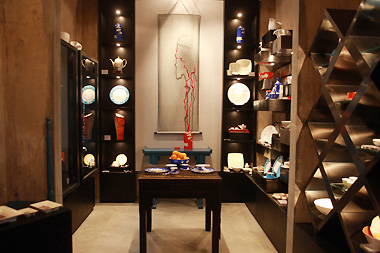 |
|
The interior of Asianera's boutique shop at Shanghai 1933.
|
"That's when I started to be serious about things, going into a kind of self-discovery period."
During our interview in her retail shop at Shanghai 1933, a new commercial hub for creative industries in Hongkou District, I referred to all the porcelain as "china," and Grace carefully clarified it.
"Terminology actually gets complicated in our business," she said.
"Ceramics is just a general term which is translated as 'taoci' in Chinese. It includes everything from 'diwen (low-fire) taoci' to 'gaowen (high-fire) taoci.' The term 'pottery' generally refers to low-fired ceramic ware, translated as 'taoqi.'
"When you say china, the general term for it is porcelain, "ci" in Chinese. The definition is sometimes blurry," she explained.
Grace's company, Asianera, has been established for 14 years and entered the Chinese mainland market seven years ago, mainly focussing on bone china.
"Bone china was a material invented by the British in the 18th century. And that was because the British loved the 'china' from China so much, they called it 'white gold'," Grace explained.
"As the 'china' items were so precious, foreign countries in the 18th century wanted to make porcelain in the Chinese way.
"But the main ingredient in Chinese porcelain is kaolin which is a special kind of clay you can only find in certain parts of the world, and it is not prevalent in the United Kingdom.
"The British then tried to figure out what could be substituted for kaolin to make a hard enough porcelain piece and they finally settled on the bone ash of cows which gives porcelain a superior transparency and durability."
The products from this style are called bone china. The term porcelain basically means high-fired ceramics that become vitrified, Grace said. "At least 40 percent of the clay formula for a good bone china body should contain bone ash. Our products contain 40-45 percent," she added.
"My goal is to preserve the craft of hand-painted china. It could be porcelain, it could be bone china, it could go either way, but I am happy that I choose bone china in the end because it really has such a fine, high-end, very elegant look.
"My other goal is to produce a very high-quality product."
She said that China, the country where porcelain was first developed, should really be the world's best manufacturer of fine china, and whether it is as porcelain or bone china doesn't really matter.
"But a high-quality, well-designed product made in China is my goal. Well-designed is a main focus for us. All the Asianera brand products are hand painted."
The production process of a hand-painted piece of porcelain is time-consuming and complicated. According to Grace, a large serving plate with a fairly complex design needs about one week to finish. As a result, the company's original designs have made Asianera products popular with many five-star restaurants and private collectors.
"I want to focus on hand painting which is definitely different from mass-produced decorating," she said. "It is kind of a dying craft. So our hope is that we are training and encouraging a new young generation of people who are interested in this craft, to carry it on and to develop it further as an artistic craft."
In order to make more people understand and appreciate the porcelain art, Grace and her colleagues have developed another brand called AE2, derived from the words Asianera too. This brand's products are not hand-painted but have a distinctive design, are more casual and significantly cheaper.
Grace believes the AE2 brand will help customers distinguish between hand-painted and mass-produced products.
"It's the uniqueness of each hand painted piece that gives it the value," she said. "Every single piece is a little bit different and you can actually see the differences in the painting and different brush strokes."
"The hand painting is most evident in water-color styles. Our patterns and layouts are contemporary in style, and we frequently use very bright, strong colors. Vibrant colors are difficult to achieve, because it requires multiple layers of color and multiple firings. And at the same time, we have to be very vigilant about producing food-safe dinnerware which tests within international safety standards. A lot of bright ceramic colors used to contain a high amount of lead and cadmium. But we use imported lead-free colors."
For Grace and her Asianera, idealism and the spirit of creation are probably the most attractive features.
"The idea we want to show through the products is that this is the new china. Our products are not reproductions of traditional designs. These are new contemporary designs coming out of China that hopefully people think are unique, beautiful and well-designed.
"We do not want to be European, we do not want to be traditional Chinese, we want to be Asianera, something really unique. We believe we are part of a new era of Chinese contemporary design."
(Shanghai Daily July 27, 2009)